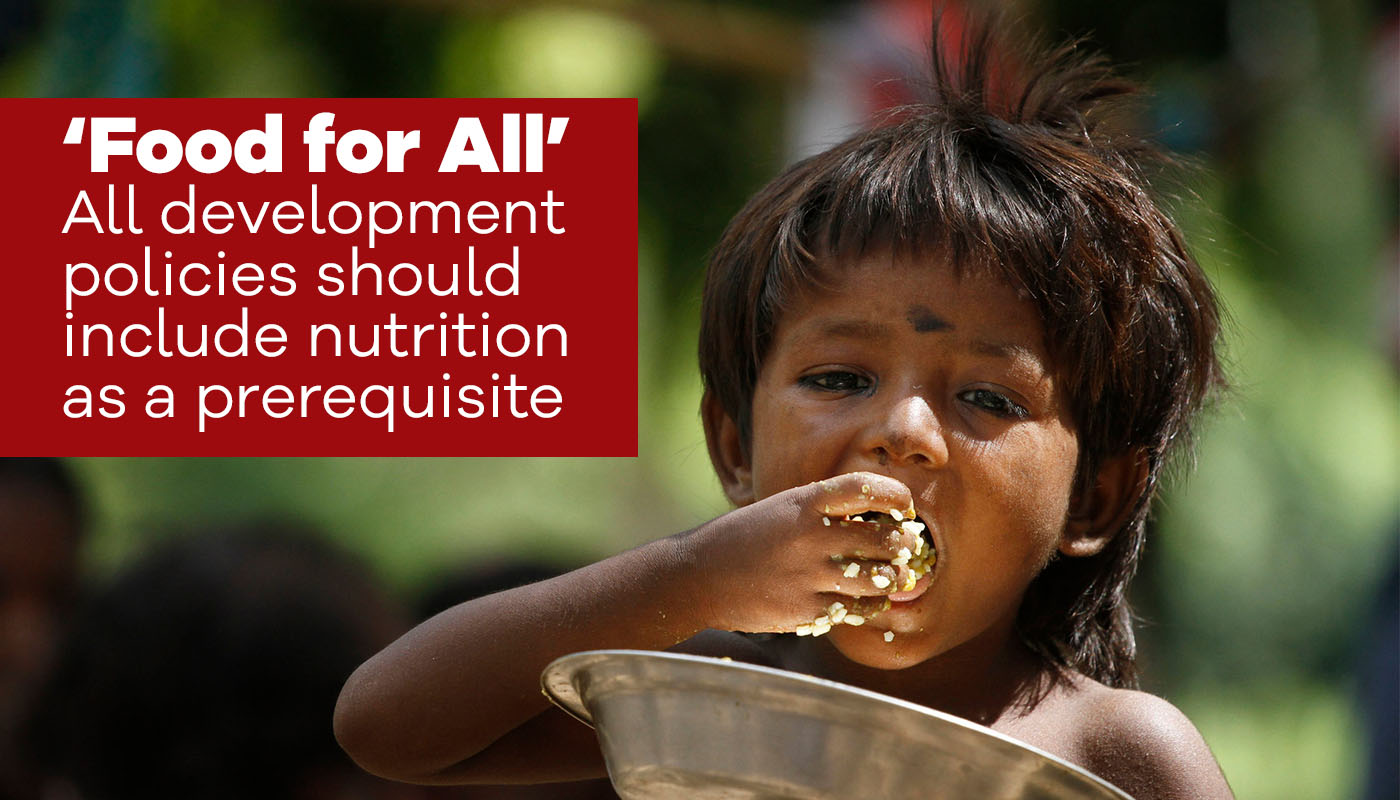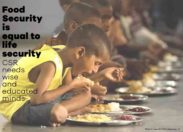Since 1947, achieving food security has been a major goal of our country. This was because the Bengal Famine created awareness of the need for paying priority attention to the elimination of hunger.
Our Food Security Act 2013 specially mentions the need for nutritional security (An Act to provide for food and nutritional security in human life cycle approach, by ensuring access to adequate quantity of quality food at affordable prices to people to live a life with dignity and for matters connected therewith or incidental thereto).
It is a known fact that undernutrition is an outcome of not one but multiple detrimental factors. These factors play their role in helping sustain this continuous burden of under-nutrition; leading to our inability to achieve our desired human resource potential, generation after another.
In order to achieve its true potential and play the role as a global superpower India will need to focus on eradication of malnutrition so as to ensure that the coming generations are healthy, enabling higher intellectual potential, leading to enhanced work productivity.
This one factor will enable us to connect the dots between schemes like Make in India, Digital India, Skill India and grow to our desired potential as a Nation.
India has made sizeable economic and social gains over the last two decades, the challenge of maternal and child undernutrition remains a national public health concern and a policy priority for the current government. India is home to over 40 million stunted and 17 million wasted children (under-five years).
Despite a marked trend of improvement in a variety of anthropometric measures of nutrition over the last 10 years, child undernutrition rates persist as among the highest in the world. This inequality is accentuated by stark disparities across states. Future improvements in nutritional status of Indian children and mothers will require significant investments into human resources with critical health investments at the local levels.
The announcement of the National Nutrition Mission (NNM) is a very significant development on this front. It has introduced a central nodal agency with extensive financial resources to coordinate various central and state government schemes and imbue them with additional financial resources. With momentum on the side of the reformers, this brief urges additional policy reforms to combat malnutrition in India.
Policy-makers need to focus on two key facts: (1) direct nutrition interventions and indirect intervention; direct intervention can solve only by 20 per cent; but indirect interventions like access to Water and Sanitation must tackle the remaining 80 per cent.
Second is that 50 per cent of the growth failure of babies accrued by two years of age occurs in the womb owing to poor nutrition of the mother. A lack of nutrition in the first 1,000 days of a child’s conception causes irreversible damage to a child’s cognitive functions. Hence, there exist significant policy returns from investing in this critical stage, that is, from the period of the conception of the child to the two-year post-natal period.
As we have Key Centrally Sponsored Schemes (CSSs) with a focus on health have seen budgetary cuts over the last two years, with central allocations to the ICDS has declined almost 10 per cent from Rs. 15,502 crore (in FY 2015-16) to Rs.14,000 crore (in FY 2016-17).
At field level, we require investment in vital infrastructure, and Anganwadi Workers (AWWs) require monitoring to ensure that they are encouraging target groups to avail supplementary nutrition. We also need to have policy which unsure good nutrition in school programme like Midday meal.
So to ensure that every person have good nutrition we have to change at policy level which required political will to focus and realise that nutrition is one of the biggest challenge we have in front of us.
1. Strengthen and restructure ICDS, and leverage PDS:- ICDS need a special focus with financial support and make sure that decision making process should make easier and decentralized with strong monitoring system. So that focus outcome can be achieve like standardise the nutritional component of supplementary food for pregnant mother, children at Anganwadi should monitor on regular basis.
2.Extend coverage of food fortification of staples Currently, fortification of staples is limited to the mandatory iodisation of salt. However, the Food Safety and Standards Authority of India (FSSAI) is in the process of formulating draft standards for the fortification of food grains which will add to the nutrient value. Additional proposals under consideration include making the double fortification of salt (with iodine and iron), and the fortification of edible oils mandatory. The standards of the hot cooked meal should also be changed to using only fortified inputs. This would help in providing sufficient calories and micronutrients to a large number of children under-five.
3. Target multiple contributing factors, for example, WASH, as the govt focusing on Swachh Bharat Abhiyan to increase the toilet in the country and trying to change the behavioural change, we still need to focus on changing behavioural aspect so that utilization of toilet could another game changer in our country.
4. Align agricultural policy with national nutritional objectives:- as more 50 percentage population engage in agriculture we need to ensure that our agriculture policy must be brought in tune with nutrition policy, with incentives provided for encouraging the production of nutrient-rich and local crops for self-consumption. Our focus should be reduce things like pesticide and need to move organic . Agriculture should be focused on securing diet quality for infants and young children.
5. Boost Community engagement in nutrition interventions without community participation it will not increase awareness among people. So need to leverage the community development organization to scaling-up food fortification interventions and to develop and distribute nutrient-rich foods to improve maternal and infant nutrition. The government should facilitate community institution (like SHGs Institution) in the sector that can leverage participation solutions for scaling up food fortification initiatives and complement the government’s outreach efforts through mass awareness.
So A healthy population is a precondition for sustainable development, and India faces significant challenges in harnessing long-term dividends from its young population. The success of the government’s numerous programmes is dependent on the availability of a trained workforce.
India has the world’s highest number of children at risk of poor development: as of 2010, 52 per cent of the country’s 121 million children (under-five) were at risk. Given the ever-increasing weight of the country’s economic ambitions, prioritizing nutrition in an integrated health agenda and realigning nutrition policy to target the first 1,000 days of a child’s life are crucial first steps towards ensuring India’s development rests on steady shoulders.
India has made a promising commitment in the form of the National Nutrition Mission which will help us tackle the problem of malnutrition in children and mothers of the country. We need to ensure effective implementation of its strategy to achieve our nutrition goals.







Leave a Reply